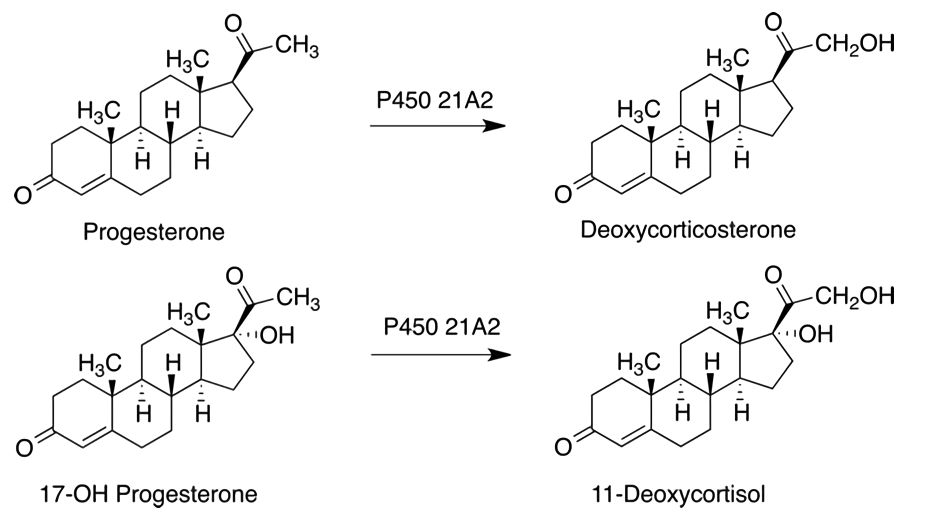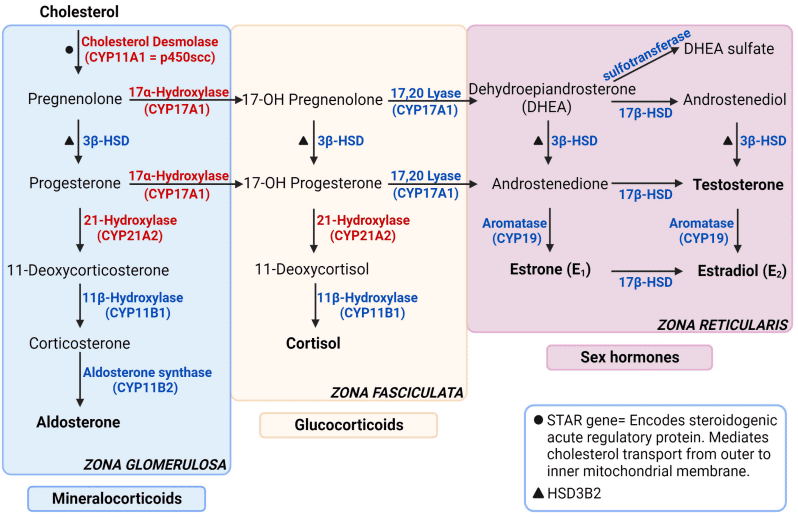NAA Services for Anti-Steroid-21-Hydroxylase (CYP21A2 or P450c21)
Anti-steroid-21-hydroxylase antibodies are a group of autoantibodies that target the adrenal autoantigens CYP21A2, the gene that codes for P450c21. Equipped with world-leading technology platforms and professional scientific staff, Creative Biolabs is always dedicated to assisting our clients with the most satisfactory scientific research services. At present, we are able to provide a full range of steroid-21-hydroxylase marker services for diseases diagnosis and therapeutic monitoring based on our well-established platforms in NAA (natural autoantibodies) research.
Background of Anti-Steroid-21-Hydroxylase (CYP21A2 or P450c21)
Steroid-21-hydroxylase, also known as steroid-21-monooxygenase, CYP21A2 or P450c21, is a kind of microsomal cytochrome P450 enzyme associated with the biosynthesis of the steroid hormones aldosterone and cortisol. This enzyme specifically catalyzes 21-hydroxylation of steroids, which converts progesterone and 17α-hydroxyprogesterone respectively into 11-deoxycorticosterone and 11-deoxycortisol by hydroxylating at the C21 position. 21-hydroxylase is expressed in the adrenal cortex and plays an essential role in the adrenal synthesis of both mineralocorticoids and glucocorticoids. Abnormality of CYP21A2 enzymatic activity usually results in congenital adrenal hyperplasia.
Anti-steroid-21-hydroxylase antibodies are a group of autoantibodies that target for adrenal autoantigens CYP21A2, which are important biomarkers of autoimmune adrenal disease.
 Fig.1 Reactions catalyzed by CYP21A2. (Zhao, 2012)
Fig.1 Reactions catalyzed by CYP21A2. (Zhao, 2012)
The Role of Anti-Steroid-21-Hydroxylase (CYP21A2 or P450c21) in Adrenalitis
The most common cause of primary adrenal insufficiency is autoimmune adrenalitis. Autoimmune adrenalitis is the most common form of adrenal inflammation, often accompanied by other autoimmune diseases, and is the most common cause of Edison's disease which caused by the destruction of corticosteroid-producing cells. In Western countries, autoimmune adrenal gland accounts for approximately 65%-90% of cases of primary adrenal insufficiency.
Recent studies indicated that autoimmune adrenalitis is characterized by the presence of several autoantibodies such as CYP21A2 (P450C21, 21 hydroxylase). These autoantibodies are involved in side chain cleavage of the steroid and subsequent hydroxylation. Serum antibodies against the steroidogenic enzymes, particularly CYP21A2, are closely related to autoimmune adrenalitis. Anti-steroid-21-hydroxylase autoantibodies dominantly belong to the IgG1 or IgG2a subclass which indicating that T helper (Th) cells are involved in the destruction of the adrenal cortex in autoimmune Edison patients. They are able to react with adrenal cortex causing steroidogenesis insufficiency at early stages, which can serve as a potential marker to predict future disease.
 Fig.2 Steroidogenesis pathway. The enzymes in red are targets for autoantibodies in autoimmune primary adrenal insufficiency.2
Fig.2 Steroidogenesis pathway. The enzymes in red are targets for autoantibodies in autoimmune primary adrenal insufficiency.2
What We Can Do for You about NAA?
NAA is a group of autoantibodies without any stimulation that can be detected in the sera of healthy humans and animals. Aided by our well-established platforms and experienced scientists, Creative Biolabs has bent ourselves in NAA studies for decades of years. Now, we are able to provide a wide spectrum of NAA products, applications, and comprehensive NAA services, including NAA detection, NAA profiling, NAA affinity measurement, NAA epitope mapping, and NAA paratope mapping and so on.
Anti-steroid-21-hydroxylase is just a representative autoantibody of our numerous researched NAA. Creative Biolabs has successfully offered a full range of related services to many global clients and helped them get satisfactory results. You can directly contact us and communicate your specific demands with us for more information. We believe that our high-quality services and professional teams will offer you satisfactory strategies.
References
- Zhao, Bin, et al. "Three-dimensional structure of steroid 21-hydroxylase (cytochrome P450 21A2) with two substrates reveals locations of disease-associated variants." Journal of Biological Chemistry 287.13 (2012): 10613-10622.
- Wolff, Anette SB, Isil Kucuka, and Bergithe E. Oftedal. "Autoimmune primary adrenal insufficiency-current diagnostic approaches and future perspectives." Frontiers in Endocrinology 14 (2023): 1285901.

